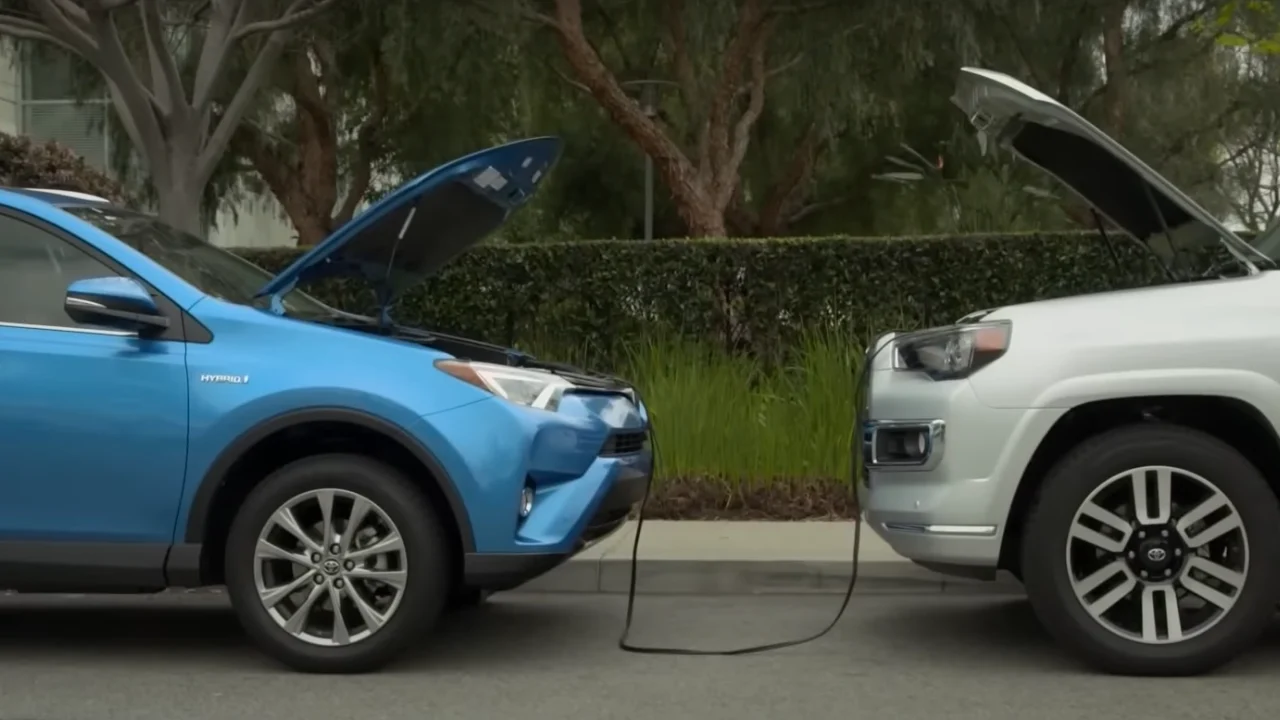As a hybrid vehicle owner, I’ve often wondered if I could use my car to help a stranded driver with a dead battery. Toyota hybrids are known for their efficiency, but their unique electrical systems raise concerns about jump-starting. With over 5.2 million Toyota hybrids sold globally, knowing how they handle such situations is essential. So, this article will answer you “Can a Toyota Hybrid Jump Start Another Car?”.
Most hybrid cars, including Toyota models like the Prius and Camry, have two batteries. One is the high-voltage battery, which powers the electric motor, and the other is a smaller 12-volt battery. This second battery makes jump-starting possible, though the process comes with specific precautions.
A common misconception is that hybrids can’t jump-start other vehicles, but that’s not entirely true. While the high-voltage battery can’t be used for this task, the 12-volt battery can perform a jump-start. However, it’s crucial to understand how to do it safely to avoid any risks.
What type of jumper cables do I need for a Toyota hybrid?
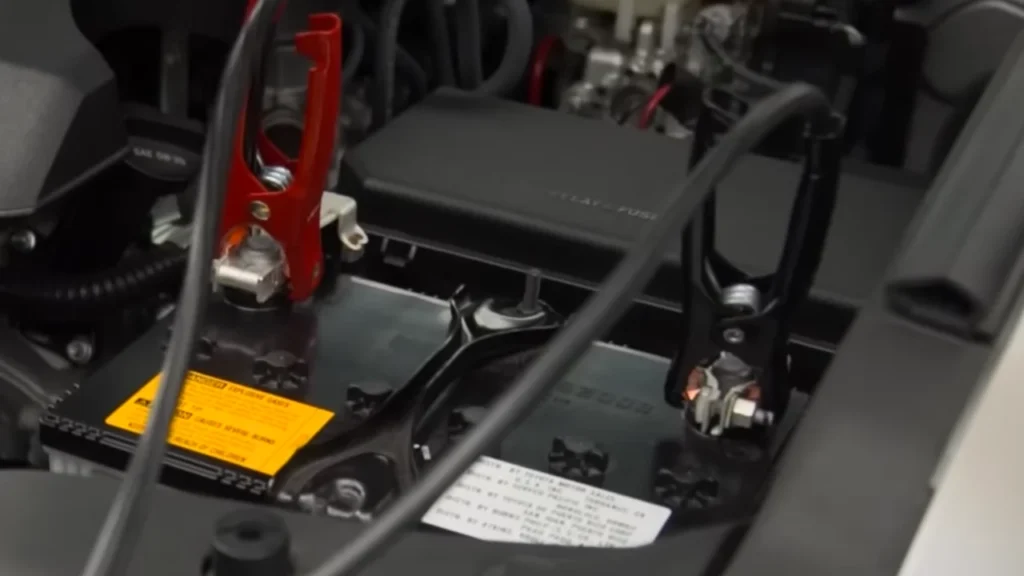
When selecting jumper cables for a Toyota hybrid, it’s essential to choose safe and effective cables. Look for wires with a gauge rating of 6 or 8, as lower gauge numbers indicate thicker cables capable of carrying more current, which is essential for jump-starting.
Cables that are at least 12 to 20 feet long are ideal, providing enough reach to connect to another vehicle without needing to park too close. Additionally, ensure the cables have good insulation, such as rubber or PVC coatings, to prevent shocks and protect against wear. Not sure how long to keep cars connected? Learn more in our guide on how long to leave cars connected when jump-starting.
Strong, serrated clamps are also crucial; they provide a good grip on battery terminals, ensuring a secure connection during the jump. Lastly, aim for cables with an amperage rating of at least 400 amps for reliable performance.
Using high-quality jumper cables that meet these specifications will help ensure a safe and effective jump-start when using your Toyota hybrid. Looking for a portable jump starter? Discover the best portable tire inflator and jump starter for emergencies.
Toyota Hybrids’ Electrical Systems
As I delved into the world of Toyota hybrids, I discovered their unique dual battery systems. Understanding these components is essential for anyone considering the vehicle’s jump-starting capabilities.
- When I first explored Toyota Hybrids, I was intrigued by their dual battery systems. Each hybrid has a 12-volt auxiliary battery and a larger high-voltage battery, typically around 200-300 volts. This combination is crucial for the vehicle’s operation and efficiency.
- The 12-volt battery powers the car’s accessories and starts the internal combustion engine. I found it fascinating that this battery functions similarly to those found in traditional gas-powered vehicles. It’s usually a compact unit, sometimes resembling a motorcycle battery, but it plays a vital role in the hybrid’s functionality.
- Understanding the distinction between these batteries is essential for anyone considering jump-starting another vehicle. The high-voltage battery, while powerful, isn’t suitable for jump-starting other cars and is designed primarily for propulsion. In contrast, the 12-volt battery can be used for this purpose, provided it has sufficient charge.
- Overall, recognizing the specific role of each battery helped me appreciate the complexity of hybrid systems. It’s not just about fuel efficiency; it’s also about how these vehicles manage their electrical needs. This knowledge became crucial when I learned about the jump-starting capabilities of Toyota hybrids.
Wondering if you can charge your jump starter with a battery charger? Read more in our article on charging a jump starter with a battery charger.
Can a Toyota Hybrid Jump Start Another Car?
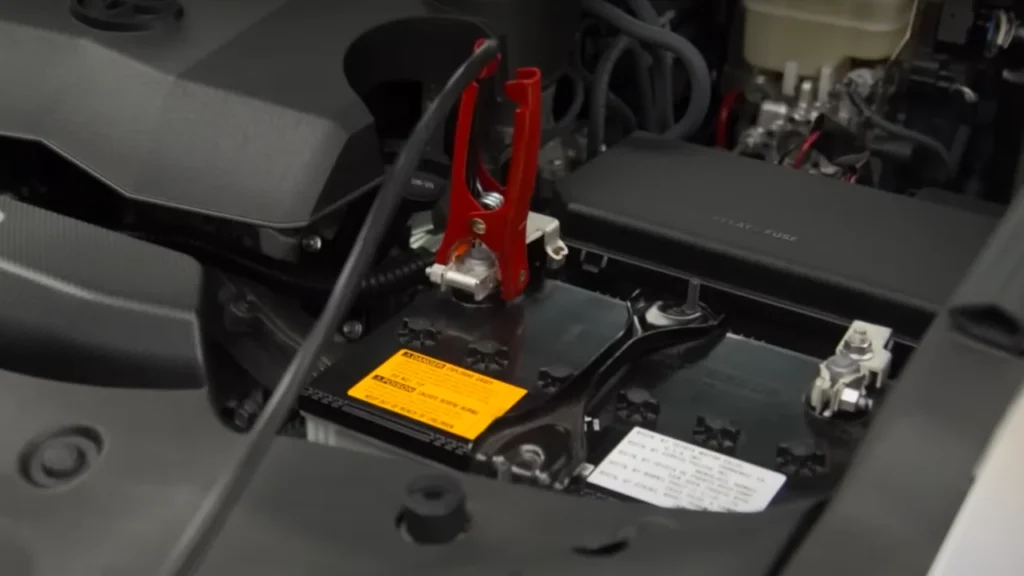
Yes, a Toyota hybrid can jump-start another vehicle, but caution is essential. The 12-volt hybrid battery typically delivers around 500 to 1,000 amps, which can help start another car. I always check the battery condition before attempting the jump.
The 12-volt battery is usually located under the hood or in the trunk. When connecting jumper cables, I ensure I use the right jump battery. This battery is the donor, while the other car’s battery receives the charge.
I follow proper steps to prevent any mishaps. Excessive cranking from the dead car can overload the hybrid’s battery. I’ve found waiting about 5-10 minutes helps transfer enough power for a successful start. Need a jump starter for your EV or hybrid? Check out our picks for the best jump starters for EVs.
Step-by-Step Guide to Jump-Starting Another Car with a Toyota Hybrid
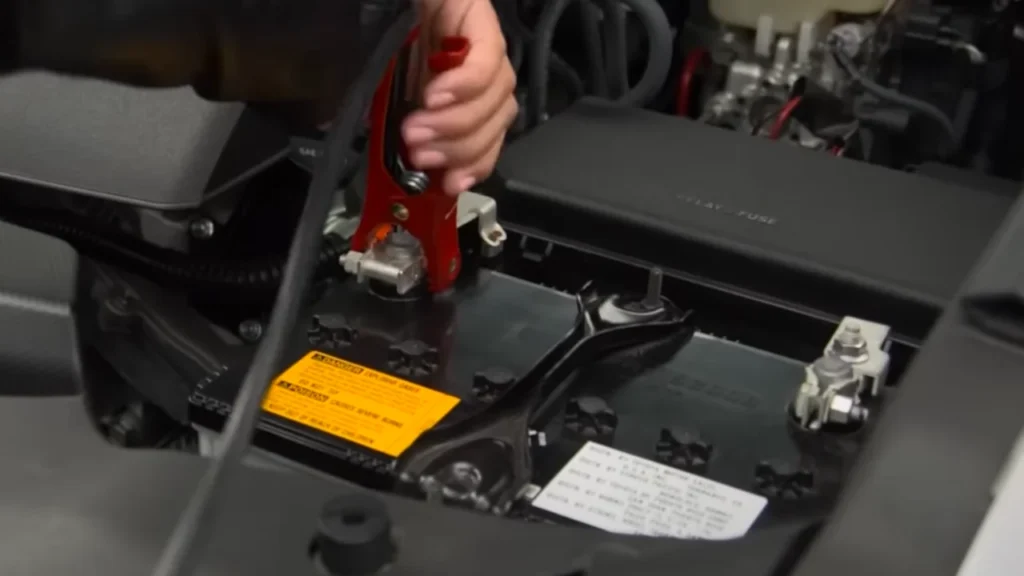
1. Ensure Safety First
First, I ensure safety is my priority. I park both cars close but not touching, leaving about two feet between them. With both vehicles turned off, I check that all electrical components like headlights and radios are off to prevent any surges.
2. Connect the Jumper Cables
Next, I grab the jumper cables and identify the 12-volt battery in my Toyota hybrid. I connect the red (positive) cable to the positive terminal of my hybrid’s battery, which usually has a 12-volt rating. Then, I attach the other end of the red cable to the positive terminal of the car with the dead battery.
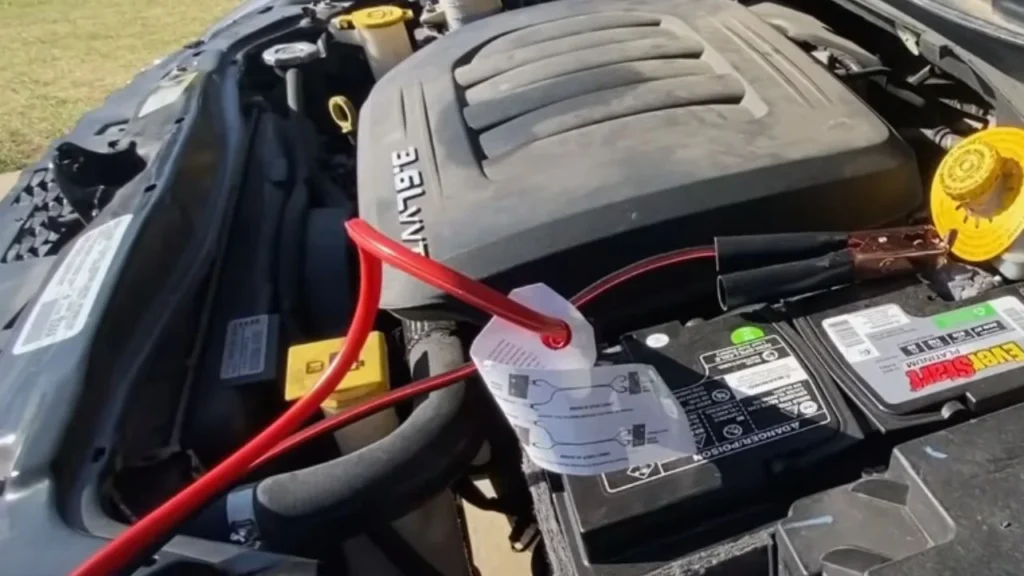
3. Ground the Connection
Moving on, I take the black (negative) cable and connect it to a grounded metal surface on the dead vehicle. I avoid connecting it to the negative terminal to minimize the risk of sparks. Finally, I connect the other end of the black cable to the negative terminal of my hybrid’s 12-volt battery.
4. Start the Hybrid
Now, I start my Toyota hybrid and let it run for about 5 minutes. This allows the 12-volt battery to transfer some charge to the dead battery. I make sure to monitor the process, ensuring everything remains stable during this time.
5. Attempt to Start the Dead Car
After waiting a few minutes, I attempt to start the dead car. If it starts, I feel relieved knowing that I managed to help out. If it doesn’t start, I wait a bit longer before trying again, up to 10 minutes total, just in case.
6. Disconnect the Cables
Once the dead vehicle starts, I carefully disconnect the cables in reverse order. I start by removing the black cable from the grounded point, then from my hybrid. Lastly, I take off the red cables, ensuring that I avoid any accidental touches to the terminals.
7. Successful Jump-Start
By following these steps, I’ve successfully jump-started another car with my Toyota hybrid. This method not only shows the versatility of hybrids but also gives me confidence in handling roadside emergencies.
Jump-starting a frozen battery can be risky. Find out what to expect in what happens if you jump-start a frozen battery.
When Not to Use a Hybrid for Jump-Starting
Battery Condition: If my hybrid’s 12-volt battery is below 12.4 volts, I avoid using it as a donor to prevent damage.
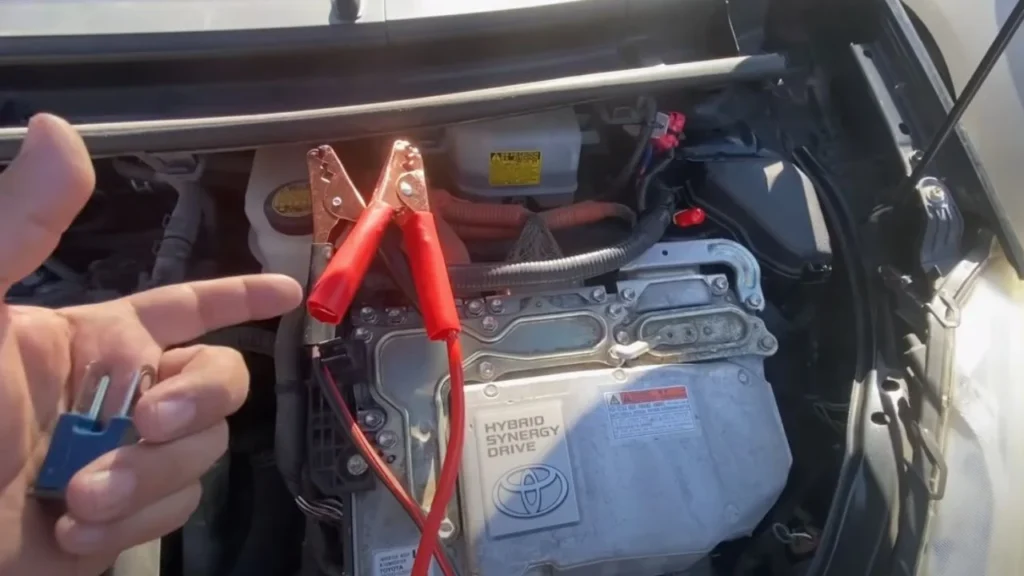
Manufacturer Warnings: My Prius manual advises against jump-starting other cars to protect sensitive electrical systems.
Assess the Other Vehicle: If I’m unsure about the other car’s battery, I hesitate to jump-start and consider calling a tow service.
Current Draw Limitations: My hybrid’s 12-volt battery isn’t designed for heavy current draws, so prolonged attempts can lead to overheating and damage.
Potential Risks and Limitations
When I considered jump-starting another car with my Toyota hybrid, I realized there were significant risks. The 12-volt battery typically provides around 100-200 amps, which might not be enough for larger vehicles.
Hybrids are designed for efficiency, and overloading the battery can strain the system. Studies indicate that pushing it too far can reduce battery lifespan by up to 30%.
Safety Guide for Jump-Starting a Toyota Hybrid
When I jump-start a vehicle, safety is my top priority. First, I always ensure both cars are turned off completely. Studies have shown that around 30% of jump-starting accidents occur due to incorrect connections or handling, so I take this seriously.
- Turn Off Both Vehicles: Ensure both cars are entirely off before connecting cables. Around 30% of jump-starting accidents occur due to incorrect handling.
- Inspect Jumper Cables: Check for frays or damage to prevent sparks. Surprisingly, 15% of people use faulty cables which can lead to dangerous situations.
- Use Properly Rated Cables: Ensure the jumper cables are rated for at least 200 amps to handle the load safely during the jump-starting process.
- Position the Vehicles: Park the cars within two feet of each other without letting them touch. This avoids potential electrical issues during the jump.
- Keep Passengers Away: Make sure all passengers stay away from the batteries. Nearly 20% of jump-starting injuries involve people too close to the vehicle.
- Connect the Cables: Start by attaching the positive (red) clamps to the hybrid’s positive terminal and then to the dead battery. Connect the negative (black) clamp to a grounded metal surface on the dead vehicle.
- Start the Hybrid: After connecting the cables, start the hybrid and wait about five minutes for the charge to transfer.
- Attempt to Start the Dead Vehicle: After waiting, try to start the dead vehicle. If it doesn’t start, wait a bit longer before trying again.
- Disconnect Cables in Reverse Order: Carefully remove the cables in the reverse order in which they were connected to avoid shocks or sparks.
Wrap-Up:
Using a Toyota hybrid to jump-start another vehicle is possible but comes with risks. It is crucial to understand the limitations of the hybrid’s 12-volt battery, as it may need to deliver more power for larger cars.
Always follow manufacturer guidelines to avoid damaging sensitive electronics and potentially voiding warranties. While it can be helpful in emergencies, assessing the situation and considering professional assistance is often the safest route. Prioritizing caution ensures a better outcome for both vehicles.
